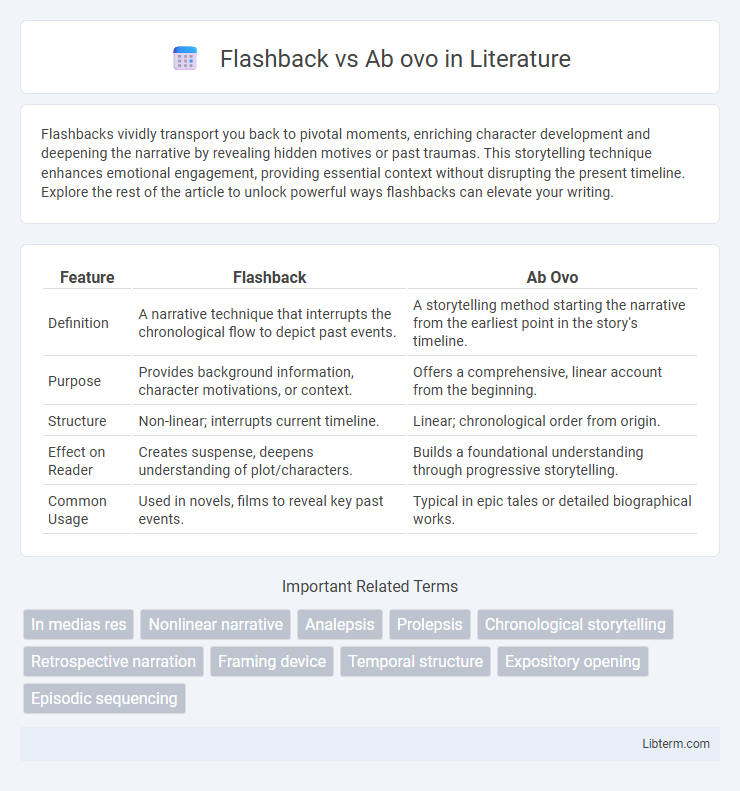Flashbacks vividly transport you back to pivotal moments, enriching character development and deepening the narrative by revealing hidden motives or past traumas. This storytelling technique enhances emotional engagement, providing essential context without disrupting the present timeline. Explore the rest of the article to unlock powerful ways flashbacks can elevate your writing.
Table of Comparison
| Feature | Flashback | Ab Ovo |
|---|---|---|
| Definition | A narrative technique that interrupts the chronological flow to depict past events. | A storytelling method starting the narrative from the earliest point in the story's timeline. |
| Purpose | Provides background information, character motivations, or context. | Offers a comprehensive, linear account from the beginning. |
| Structure | Non-linear; interrupts current timeline. | Linear; chronological order from origin. |
| Effect on Reader | Creates suspense, deepens understanding of plot/characters. | Builds a foundational understanding through progressive storytelling. |
| Common Usage | Used in novels, films to reveal key past events. | Typical in epic tales or detailed biographical works. |
Introduction to Narrative Techniques: Flashback and Ab Ovo
Flashback and ab ovo are fundamental narrative techniques shaping story structure and temporal flow. Flashback interrupts the chronological sequence to reveal past events, enriching character development and plot depth. Ab ovo presents the story from its very beginning, offering a linear and comprehensive narrative foundation.
Defining Flashback in Storytelling
Flashback in storytelling is a narrative technique that interrupts the chronological flow to depict past events, providing crucial background information that shapes character motivations and plot development. Unlike ab ovo, which starts a story from the very beginning, flashbacks insert selective memories or incidents to enrich the present narrative context. This method enhances thematic depth and emotional resonance by revealing hidden connections and unresolved conflicts from earlier times.
Understanding Ab Ovo: Starting from the Beginning
Ab ovo, a Latin term meaning "from the egg," refers to narrating a story from its very beginning, providing comprehensive background and context. This method contrasts with flashback, which interrupts the chronological flow to reveal past events selectively. Understanding ab ovo enhances narrative clarity by offering an uninterrupted, linear progression from origin to conclusion, benefiting readers seeking complete story immersion.
Key Differences Between Flashback and Ab Ovo
Flashback presents past events within the narrative to provide background or context, disrupting the chronological flow, while ab ovo starts the story from the very beginning, offering a linear progression from origin to conclusion. Flashbacks often reveal crucial character motivations or plot twists, whereas ab ovo ensures a comprehensive understanding by narrating events in their natural sequence. The key difference lies in the narrative structure: flashbacks interrupt the timeline for emphasis, and ab ovo maintains continuity by unfolding events in order.
Narrative Structure: Impact on Plot Development
Flashback disrupts chronological order by revealing past events that influence character motivation and clarify plot context, heightening suspense or emotional depth. Ab ovo presents the story from the very beginning, offering a linear progression that builds cause-and-effect relationships clearly and allows viewers to track character development naturally. The choice between flashback and ab ovo shapes narrative pacing, with flashbacks introducing complexity and ab ovo emphasizing coherence in plot development.
Reader Engagement: Flashback vs Ab Ovo Approaches
Flashbacks enhance reader engagement by revealing key backstory elements dynamically, creating suspense and emotional depth without interrupting the narrative flow. In contrast, the ab ovo approach provides a chronological start that offers clarity and context but may delay engagement due to slower plot development. Flashbacks often encourage active reader interpretation, while ab ovo builds a structured understanding from the foundation upward.
Effect on Character Development in Narratives
Flashback enhances character development by revealing past experiences that explain current motivations, deepening psychological complexity and emotional resonance. Ab ovo presents characters from the beginning, allowing audiences to observe growth and transformation over time, fostering a comprehensive understanding of their evolution. Both techniques shape narrative structure but differ in pacing character insight and emotional engagement.
Popular Examples in Literature and Film
Flashback and ab ovo are narrative techniques widely used in literature and film to manipulate the timeline for storytelling impact. Flashback interrupts the chronological flow, providing past events crucial for character development or plot revelation, as seen in "The Great Gatsby" where Nick Carraway reflects on Jay Gatsby's past, or in the film "Titanic" with Rose's reminiscence of the tragic voyage. Ab ovo, starting the story from the very beginning, is exemplified in Homer's "The Odyssey," detailing Odysseus' entire journey from Troy, and in the film "Forrest Gump," which narrates Forrest's life from childhood to adulthood in a linear fashion.
Choosing the Right Technique for Your Story
Flashback and ab ovo serve distinct narrative purposes, with flashback revealing crucial past events to enhance character motivation or plot depth, while ab ovo begins the story at its chronological start, providing a comprehensive foundation. Choosing the right technique depends on the story's structure and pacing needs; flashbacks work best for layered, suspenseful storytelling, whereas ab ovo suits linear, character-driven narratives aiming for thorough background exposition. Effective use of these methods improves reader engagement by aligning narrative flow with thematic emphasis and plot complexity.
Conclusion: Crafting Effective Narratives with Flashback and Ab Ovo
Flashback and ab ovo structures each serve distinct narrative purposes by manipulating temporal flow to enhance storytelling depth. Flashback inserts past events into the present narrative to reveal character motivations and backstory, creating suspense and emotional resonance. Ab ovo, starting the story from its chronological beginning, establishes a clear, linear progression that fosters comprehension and contextual understanding.
Flashback Infographic

 libterm.com
libterm.com